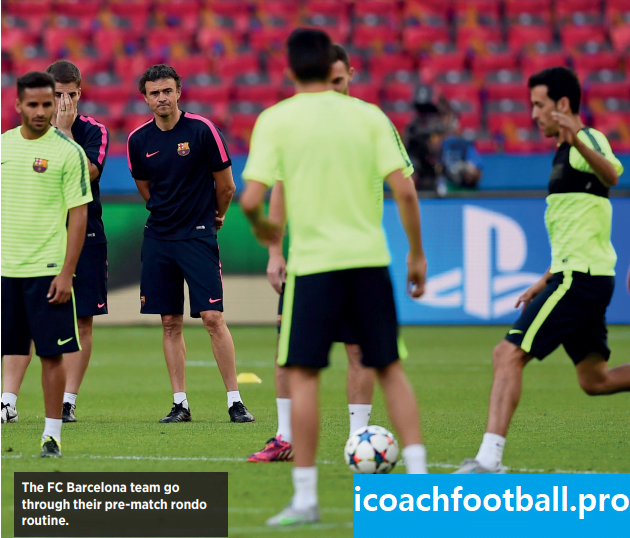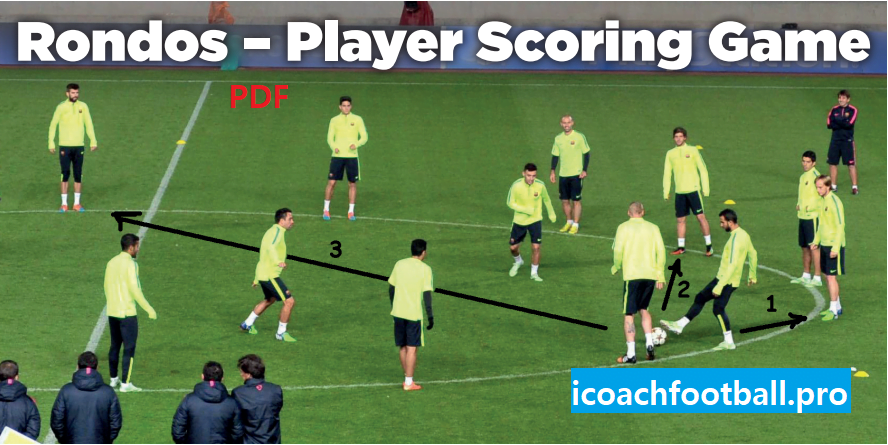Table of Contents
Introduction
Are you looking for new and exciting ways to train your football team? Look no further! In this blog post, we will be discussing 77 Rondo Game Exercises that you can incorporate into your training sessions. These exercises are designed to improve your players’ technical skills, decision-making abilities, and overall understanding of the game.
What is Rondo?
In Spanish Rondos means “round” Rondos are games where one group of players has the ball with overload advantage (3v1, 4v2, 5v2, 6v3) over another group of players.
The basic objective of the group in overload advantage is to keep possession of the ball while the objective of the group with fewer players is to win the ball back. Rondos are usually set up in a grid, which can be anything from 8×8 yards to a half pitch depending on the skill level of the players or the aspect of play you want to be worked on.
In a Rondo, there are key passes like a 1st line pass, a 2nd line pass, and a 3rd line pass. Usually it is played with one touch passing, but that can be changed depending on the parameters.
The size of the square as well as the amount of players on each team are variable. The goal is usually to reach 20 or 30 passes in a row without an interception. Once that is achieved the players all tease and applaud towards the players in the middle.
If you watch any of the training videos uploaded by Bayern Munich on YouTube you can hear players like Thomas Muller counting each pass out loud. They are based on a technical practice but they can also be set up to work on many tactical and positional aspects of play.
How To use Rondo Games ?
The size of the grids are relevant to the individual practices. Teams like Barcelona and Bayern Munich want to be playing passes 10 yards and less, and when all the players are this distance apart, they can press the ball intensely should they lose possession.
“Everything that goes on in a match, except shooting*, you can do in a rondo. The competitive aspect, fighting to make space, what to do when in possession and what to do when you haven’t got the ball, how to play one touch soccer, how to counteract the tight marking and how to win the ball back” – JOHAN CRUYFF *you can even shoot in these Soccer Coach Weekly rondos!
A rondo is a type of game, similar to keep away, that is used as a training drill in association football (soccer). In a rondo, one group of players is tasked with keeping possession of the ball while completing a series of passes, while a smaller group of players (sometimes a single player) tries to take possession.
Rondos take place in close proximity, with the possessing group often circled around the opposing group. Unlike other possession games, in a rondo, players occupy predetermined positions. Rondos are said to improve player decision making, coordination, team play, creativity, competitiveness, and physical conditioning.
The exercise has been used by major football organizations, including Derby County F.C. in the early 70’s, and later FC Barcelona and Ajax, and has been credited with remaking the modern game. Dutch player and coach Johan Cruyff, who implemented the rondo at Barcelona, described the drill:
“Everything that goes on in a match, except shooting, you can do in a rondo. The competitive aspect, fighting to make space, what to do when in possession and what to do when you haven’t got the ball, how to play ‘one touch’ soccer, how to counteract the tight marking and how to win the ball back.”

What is a Rondo Game Exercise, you ask?
Well, a Rondo is a small-sided game that is played in a confined space. It is typically played with one or two players in the middle and the rest of the players on the outside. The objective of the game is for the attackers to keep possession of the ball while the defenders try to win it back.
Key Benefits of Rondo Training
The development of a young player’s tactical and positional work is key to rondos – but the technical side is also a big plus when you consider the benefits of using them
COGNITIVE
Players have to constantly make decisions in relation to things like teammates, opponents, position of the ball. Mistakes result in loss of the ball and a player going into the center so it encourages players to make the correct decisions and quickly.
ONE AND TWO TOUCH PASSING
Rondos help create the environment where 1 or 2 touches is all you can have.
TECHNICAL
Due to the way that the rondo is set up, it is necessary to have control of the physical movements and technical skills with respect to time and space, the game, the ball and opponents.
RHYTHM OF PLAY AND TEMPO
Rondos can help players understand when to play quickly and when to put their foot on the ball and slow things down depending on how close the opposition player is.
TEAM BUILDING
With the type of work done in rondos, the understanding between teammates is improved, and the sense of “team” becomes the norm.
KEEP POSSESSION
Rondos are keep ball games. You have to keep the ball off the players in the middle. It’s their job to get the ball, so you need to work together as a group – a key part of winning soccer matches.
CREATIVITY AND EXPRESSION
The set up of rondos forces the players to use various technical and tactical techniques to solve constantly changing situations within the game. This helps develop creativity.
IMPROVED CONTROL
The tight spaces forces players to have a good first touch to give them the time and space to keep control of the ball.
COMPETITIVENESS
Competition between players is high. Players have to fight to make space, learn how to hold off a tight marking and how to win the ball back. Nobody wants to be the one making the mistake which leads to time in the middle.
SHORT PASSING
Rondos are all about short passing in tight areas of the game. Using rondos gives your players lot of practice playing passes at short distances under pressure.
PHYSICAL CONDITIONING
With rondos a team works on agility, balance and coordination by varying the space, time and number of players involved.
MOVEMENT OFF THE BALL
Players must understand that they continue moving after they have passed the ball – stay available for the ball to be passed back, or run into space to provide another option. In this way players always have a passing option.
“It’s all about rondos. Rondo, rondo, rondo. Every single day. It’s the best exercise there is. You learn responsibility and not to lose the ball. If you lose the ball, you go in the middle. Pum-pum-pumpum, always one touch. If you go in the middle, it’s humiliating, the rest applaud and laugh at you” – XAVI
Now, let’s dive into the 77 Rondo Game Exercises that we have compiled for you:
These are just a few examples of the Rondo Game Exercises that you can incorporate into your training sessions. The key is to vary the size of the playing area, the number of players involved, and the rules of the game to keep your players engaged and challenged.
- Rondo Circle: In this exercise, the players form a circle and try to keep possession of the ball by passing it to each other. The defenders in the middle try to intercept the passes.
- Rondo Square: Similar to the Rondo Circle, but the players form a square instead of a circle.
- Rondo Triangle: Again, similar to the Rondo Circle, but the players form a triangle.
- Rondo Diamond: You guessed it! The players form a diamond shape in this exercise.
But where can you find these 77 Rondo Game Exercises? We have got you covered! We have created a PDF document that includes detailed instructions and diagrams for each exercise.
So, what are you waiting for? Start incorporating these Rondo Game Exercises into your training sessions and watch your players’ skills and understanding of the game improve!
77 Rondo Game Exercises ENGLISH PDF

Nice
Thanks so much for a wonderful package and hope it goes a very longway to bring a positive impact to the individual and general team development if well implemented. Thank you
Thank you very much for your efforts in making the Coaching easy more blessings Sir.
Coach Ibraheem Diekola Busari Ibadan Oyo State of Nigeria